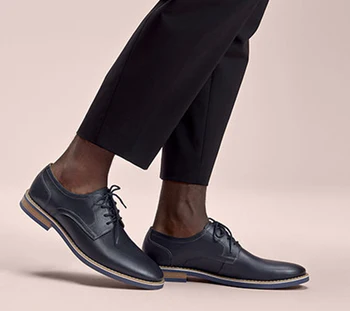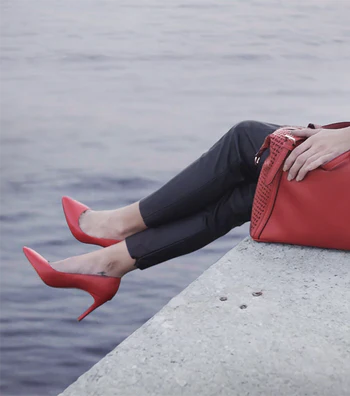“Shoes that are too tight, too loose, or without enough support, can lead to unwanted stress on the feet, ankles, lower leg, hip, and spine. Fortunately, many foot-related problems can be prevented with shoes that are appropriate for an individual's feet, body, and lifestyle.” - Catherine K. Irwin, PT, MHS, OCS & Brian M. Weatherford, MD for OrthoInfo.org.

According to a recent study, upwards of 75 per cent of adults have experienced occasional foot pain. Although this isn’t totally surprising when you think about how much pressure we put on our feet over the course of a day, we firmly believe that with current technologies available in footwear—no one should have to suffer. In fact, we strongly suspect that a lot of this discomfort arises from improper or poorly-fitting shoes. Aesthetics aside, choosing the right shoe is also a matter of health. Going in with a mindful and informed approach is essential when selecting the right shoes to help you live your best life.
Don’t worry, though, you don’t have to compromise style for comfort. Today, we will share some strategies for helping you choose the right shoes based on your foot type. So whether you’re on the narrow or wide side, have high or low arches, read on to find everything you need to buy shoes that will make your feet happy.
Don’t forget about the width
You probably know your exact shoe size when it comes to the length of your foot, but what would you say if we asked you about width? Most people simply don’t spend much time thinking about the size and shape of their feet (fair enough), but the thing is that shoes that are too narrow or too wide can cause serious problems.

How to find the best shoes for narrow feet
If you find your feet tend to slide around in your shoes, the chances are that you have narrow feet. While it's possible to modify standard-width shoes to accommodate your foot structure, there are some strategies you can use to find the best shoes for your unique foot. This will help reduce your risk of injury and help you get the most out of your days.
Start with a narrow-width shoe or snug-fitting features
Designed for narrow feet, narrow shoes are typically just over half a centimetre narrower than standard shoes. If you're unsure about the width of a shoe, you can check with a salesperson at your local Bata store who will be happy to help you.
Select naturally narrow shoe styles
High heels are just one example of a style often well-suited for narrow feet. Despite having a reputation for being uncomfortable, with the right pair of heels chosen specifically for your foot shape, you should barely notice you’re wearing them. Our Bata Insolia, for instance, balances weight evenly across your foot, reduces foot pressure, improves posture and balance, and dramatically extends comfortable wear time.
If you're looking for casual shoes or boots, you may find that styles with a shallower toe box, tapered heel, higher arch or outsole that narrows at the arch tend to naturally fit a narrow foot better. Finally, lace-up shoes are another great option for people with narrow feet, as they can be adjusted to provide a snug, slim fit.
Add an Insole or Socks
If you can't find a shoe you want in a narrow width, another option is to add an insole in order to increase the security of the fit. Find an insole that provides the appropriate level of arch support and cushioning, such as our Bata leather insole or a memory insole. Then simply place it in your shoe to reduce slipping or sliding and reduce overall friction.
Another option is to wear a thicker sock. While this may not work with every shoe, in some cases, the sock can compensate for any extra space on the sides of your foot and can help prevent unnecessary movement.
How to find the best shoes for wide feet
Most shoes are designed for feet of standard dimensions. Therefore, it is necessary to approach shoe shopping mindfully if you have wide feet and adhere to some principles that will allow you to avoid compromising when it comes to comfort.
If the shoe doesn’t fit, don’t buy it
It can indeed be frustrating if you find a style you love, but it feels tight along the sides when you try it on. Nevertheless, it is not worth it to buy shoes hoping that they will loosen up. It’s unlikely to happen, and even if it does—it will be at the price of a lot of strain put on your feet, which leads to more problems. There are shoes out there designed for wide feet, so be patient and hold out for the right pair.
Choose laced shoes over slip-ons or shoes with straps
Overall, laced shoes are much easier to adjust than slip-ons or strapped shoes. So, as a rule, if you have wide feet, go with shoes that have flexible elements, whether they are straps, buckles, elastic bands, laces, or velcro straps.
The same goes for high heels. In addition to open toe heels, which are great because they provide more breathing room, you should also look for elevated shoes with fastening you can easily alter. Embrace all that adjustable freedom, and your foot will be safer for it.
How to find the best shoes for flat feet
A common and generally painless foot condition, having flat feet means that the sole of your foot doesn’t arch. Instead, the entire (or almost the entire) sole is in contact with the ground when you’re standing. Here is how to pick shoes that will offer maximum comfort.

Opt for a more supportive fit
A supportive sole is indeed the friend of a flat foot. A flat foot benefits from a heavier, less flexible shoe; the midsole should provide most of the cushion and support. Our Bata 3D Energy sneakers, for example, are designed to offer impact absorption, stability and cushion. The rebound sole, heel stabiliser, and memory foam insole are perfect for those who need a little extra support. You can learn more about the technology used in our 3D sneakers here.
Find the right type of arch and heel support
Ideally, you should choose shoes with extra support in the middle of the sole. This will help take pressure off the centre of your foot and ensure that you can keep good alignment. Backless sandals and flip flops are usually to be avoided for those with flat feet. They simply don’t provide the supportive soles you need.
You want shoes that enclose your heel so that the sole of the shoe and your foot move together. When it comes to high heels, you should look for a lower heel with good arch support—kitten heels and styles that are around five centimeters tall or less are ideal. For added comfort, our heel cushion insole, and its luxurious little pillows, are a perfect way to prevent your heel from rubbing, while also providing cushioning and shock absorption.
How to find the best shoes for high arched feet
Alternatively, some people have higher arches than average. This condition is called cavus foot, and it’s fairly common. That said, high arches can cause foot pain and might increase the risk of ankle injuries, so finding the right shoe is important.
Look for a shoe that matches the shape of your foot
Generally, you want to look for shoes with a supportive midsole. Many athletic shoes, like our 3D collection mentioned above, are designed to provide arch support. In addition, soft insoles that mould to your foot shape and reach the top of your arch are also helpful.
If you have high arches, you may also find higher heels comfortable, so explore our range of high heels and take your pick.
Choose high tops or extra cushioning
If you have high arches, you also need to be aware of ankle support. Shoes or boots that are snug around the ankle can prevent excessive twisting and subsequent injuries. A slight heel lift can also take pressure off the Achilles tendon.
A high arched foot also benefits from a cushioned shoe, such as those provided in our Comfit collection. The fundamental idea behind Comfit was to take the comfort and feeling of wearing sneakers and replicate this experience across many different shoes and sandals. The combination of extra cushioned insoles, ergonomic fit and anti-slip outsoles, offers added shock absorption and results in the most comfortable walking experience possible. You can learn all about the innovative tech used in our Comfit range here.
Bonus tips and the final word on shoe fit and foot types
With the technology we’re now able to incorporate into our footwear, there is no reason that you can’t have a comfortable and stylish fit—regardless of your foot size. The best way to determine if you’ve found the shoe for you is to pay attention to how it feels. Finally, remember that:
- Even if a shoe isn’t your standard size—if it feels right to you then trust that.
- You should never have to ‘break shoes in’ for them to fit correctly.
- You should always try on shoes at the end of the day when your feet are at their largest due to normal swelling.
- You should always stand and walk around in the shoes to see if they are comfortable, fit well, and don’t chafe or rub anywhere. Your heel should not slip or slide while walking.
- Never assume dress shoes should be uncomfortable. Many dress shoes are now made with a sneaker-like sole that provides better cushioning and tread and better arch support.
At Bata, we believe that everyone deserves the perfect fit, and we are confident the right shoe awaits you in our collection. Happy shopping!





